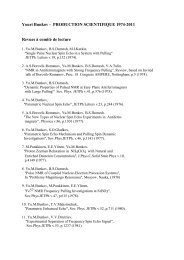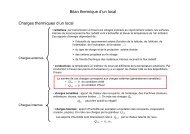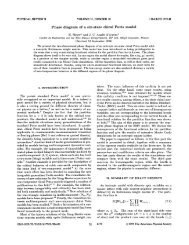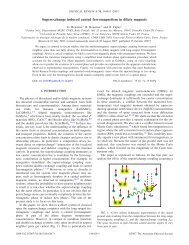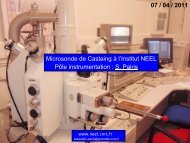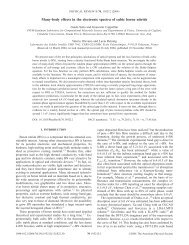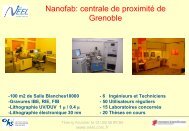Book of abstracts - Euro-MBE 2011 - CNRS
Book of abstracts - Euro-MBE 2011 - CNRS
Book of abstracts - Euro-MBE 2011 - CNRS
Create successful ePaper yourself
Turn your PDF publications into a flip-book with our unique Google optimized e-Paper software.
Mo2.1<br />
<strong>MBE</strong> growth <strong>of</strong> LiMnAs<br />
Vít Novák<br />
Institute <strong>of</strong> Physics <strong>of</strong> the Academy <strong>of</strong> Sciences, Cukrovarnická 10, 162 53 Praha, Czech Republic<br />
Compound semiconductors derived from silicon have had a tremendous impact on the physics and<br />
applications <strong>of</strong> semiconductors. Two textbook examples are the direct gap III-V semiconductors and<br />
the prototype magnetic II-VI semiconductors, Fig.1. Remarkably, none <strong>of</strong> the other closest relatives <strong>of</strong><br />
silicon from the I-III-IV and I-II-V compounds have so far been synthesized by modern epitaxial<br />
growth techniques and the potential <strong>of</strong> these compounds has remained virtually unexplored. In this<br />
talk we focus on I-Mn-V compounds which surprisingly have not previously been considered as<br />
candidate semiconductors. One <strong>of</strong> the key motivations to establish their semiconducting electronic<br />
structure is that they are among the rare known silicon relatives with magnetic ordering temperature<br />
safely above room temperature.<br />
Fig.1: Closest relatives <strong>of</strong> silicon emerging by applying the “proton transfer” rule.<br />
We demonstrate on LiMnAs that high-quality materials with group-I alkali metals in the crystal structure<br />
can be grown by standard solid source molecular beam epitaxy [1]. The epitaxial LiMnAs film exhibits<br />
optical gap, evidenced by optical transmission measurements and consistent with the band structure<br />
obtained by our ab initio calculations. Squid magnetometry measurements support earlier reports <strong>of</strong><br />
high antiferromagnetic ordering temperature.<br />
We propose a strategy for employing I-Mn-V compounds in high-temperature semiconductor<br />
magneto-electronics. The key principle is to utilize relativistic magnetic and magneto-transport anisotropy<br />
effects whose common characteristics is that they are an even function <strong>of</strong> the microscopic magnetic<br />
moment vector and are therefore in principle equally well present in materials with ferromagnetic (FM) and<br />
antiferromagnetic (AFM) order. The application <strong>of</strong> AFM semiconductors to exchange bias FMs opens an<br />
immediate research opportunity for integrating conventional semiconductor micro and opto-electronics<br />
functionalities directly in the exchange-biasing AFM layers in common magneto-electronic devices. In<br />
these structures LiMnAs can be combined, e.g., with lattice matched FM semiconductor (In,Mn)As or<br />
conventional transition metal FMs. The FM-AFM coupling can also be used for controlling the staggered<br />
moment orientation in the AFM by the exchange spring effect induced by rotating moments in the<br />
ferromagnet.<br />
[1] T. Jungwirth, et al., Phys. Rev. B 83, 035321 (<strong>2011</strong>).<br />
_______________________<br />
* Contact: vit.novak@fzu.cz



